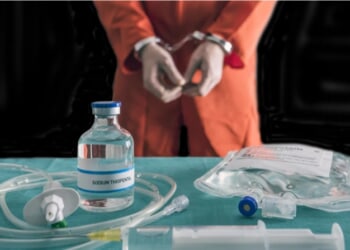
Gender-affirming pediatricians don’t offer uncertainty. They offer the confidence of settled science: the young people who enter their clinics are “transgender,” and medical interventions, such as hormone treatments and genital surgeries, will align their brains with their bodies. While no scan or blood test can verify this diagnosis, treatment begins regardless.
In modern medicine, “being transgender” is often portrayed as a condition with biological underpinnings. This belief endures despite decades of unsuccessful searches for an objective biomarker.
Finally, a reason to check your email.
Sign up for our free newsletter today.
Jonni Skinner, a detransitioner who received “gender-affirming” medical care as a child, shows the human cost of that belief. Jonni grew up in a small Michigan town with his mother and brother, moving from place to place amid an unstable home situation. At the age of four, he was diagnosed with Autism Spectrum Disorder. He was a sensitive and empathetic child, which made him a target for bullies.
Jonni had a devout Christian upbringing and took his faith seriously. As adolescence arrived, his emerging same-sex attraction became a monumental source of stress because he believed being gay was a sin. His anxiety quickly turned into depression.
Online and on television, he encountered a different story about boys like him. YouTube personalities Gigi Gorgeous and Stef Sanjati, and reality TV figure Jazz Jennings, were effeminate, same-sex-attracted boys whose transitions played out in public. They appeared happy, successful, and self-possessed. For Jonni, it was easy to believe that following their path might offer the same relief.
The chance to speak with a specialist came through a family friend who tutored Jonni—a lesbian who had begun identifying as a transgender man and taking testosterone. She referred him to the University of Michigan’s pediatric gender clinic at C. S. Mott Children’s Hospital.
Jonni did not walk in at 13 years old convinced he was transgender; he wanted clarity about the distress he was feeling. The clinic supplied that clarity on its own terms. Jonni claims that after a single three-hour intake interview, a clinical social worker affirmed him as “transgender” and placed him on a medical track.
At the clinic, Jonni was seen by Daniel Shumer, a pediatric endocrinologist. According to Jonni, Shumer told him he had a “neurological intersex condition” and that medical treatment was the only effective way to align his brain with his body. Jonni remembers the conversation in explicit detail, because it was pivotal in deciding the course for him and his mother. (Shumer declined a request to comment for this article.)
In the consultation room, Jonni claimed, Shumer used a whiteboard to sketch a prenatal hormone pathway: in the womb, a mistimed androgen signal in early development had “feminized” his brain, while testosterone had masculinized his body later on. Jonni says that his distress was presented as a brain-body mismatch.
The brain-body mismatch story took shape in the 1960s, when researchers first proposed brain-based explanations for transsexuality. By 1980, psychiatry was pivoting toward a biomedical model, anticipating that neuroimaging would reveal biological signatures of mental disorders. The search for a “transgender brain” followed.
In 1995, a Dutch team published a small postmortem study in Nature of six males who identified as women, reporting that their hypothalamic region more closely resembled the typical female pattern. This was widely considered a landmark finding. But later analyses of this study suggested that long-term cross-sex hormone use, known to alter brain structure, was the more likely explanation for the similarities found between trans-identifying people’s brains and those of the opposite sex.
Clinicians nonetheless proceeded to develop clinical guidelines on the expectation that biological evidence would emerge to validate their proposed medical interventions. Within a few years of the Nature study, Dutch clinicians created the first protocol to alter the sex characteristics of gender-dysphoric adolescents, introducing puberty blockers and cross-sex hormones at the onset of puberty. In 2007, Boston endocrinologist Norman Spack imported the “Dutch protocol,” as it came to be known, to the United States when he opened the nation’s first pediatric gender clinic.
This clinic became ground zero for the gender-affirming model of care in the United States. Spack framed transgender identity as a medical condition and described people identifying as trans as having been “born with brains that didn’t fit their bodies.” Shumer trained under Spack, and in 2015, built a program in Michigan for minors on the same “gender-affirming” template.
Dutch researchers continued to pursue biological explanations for transgender identity, even as clear evidence remained elusive. In 2009, they offered a simple account: transsexualism could result from a mismatch between the differentiation of a fetus’s genitalia (which occurs within the first two months of pregnancy) and the sexual differentiation of the fetus’s brain (which occurs in the second half). They claimed “[t]here is no proof that social environment after birth has an effect on gender identity or sexual orientation.” This became the foundation of the script that Shumer allegedly presented to Jonni.
“So, he explained I wasn’t gay, I simply had a female brain in a boy’s body. And how the inverse happens to create a trans man,” Jonni said. He came away convinced that he “was literally in the wrong body,” and that “[a medical intervention] is the only treatment that would work.”
To reinforce what he allegedly told Jonni, Shumer emailed him a 2014 clinician review by pediatric endocrinologist Stephen M. Rosenthal and colleagues, which devoted pages to the “Current Concepts of the Biology of Gender Identity.” It summarized studies on differences of sex development (DSDs), brain structure and function, genes, and twin concordance, which are often invoked to suggest a biological contribution to transgenderism.
DSD studies examine congenital differences in sex development involving chromosomes, gonads, or genital anatomy, usually in patients with complex medical histories. In the transgender research literature, researchers lean heavily on DSD papers and often present them as the strongest evidence that “gender identity is fixed.”
Yet the people in these studies, who have atypical sexual anatomy, are generally not comparable to those who identify as transgender. While the idea of “gender identity” emerged in DSD research and may have utility in that narrow context, it was later applied to transgender research as the basis for biological inquiry. But gender identity is an unfalsifiable construct—it relies entirely on self-report, based on how people say they feel, with no independent way to observe, measure, or disprove it—making it a weak foundation for biological claims.
Studies of brain structure and function report differences between trans-identified groups and non-trans control groups. But when confounding factors such as same-sex attraction and long-term cross-sex hormone use are controlled for, the effects shrink or disappear.
Genetic studies have found small differences in androgen- and estrogen-receptor genes between trans-identified groups and non-trans control groups. Those same variants also appear in the general population and are linked to sex-atypical traits and interests. In plain terms, they reflect normal variation in traits and interests that are less typical for one’s sex. This variation is more common in trans-identified groups, but it is not unique to them and is not a biological marker of “being transgender.”
Twin research is often cited as the strongest evidence for a genetic role in the development of transgender identity. But since these studies often involve twins who were reared together, they cannot reliably separate heredity from the effects of having been raised in a shared environment. In these studies, concordance—which means, in this context, that both twins identify as transgender—is concentrated among same-sex–attracted identical twin pairs. The results are modest for identical twin pairs, and near-zero among fraternal twins, which is out of step with standard genetic expectations for heritability. Identical twins also have closer social bonds and are more likely to imitate each other than fraternal twins, which means that social influence can help explain their higher concordance rates.
Taken together, none of these lines of evidence demonstrates a biological basis for transgender identities per se. But to Jonni and his mother, who trusted physicians and had only a layman’s grasp of biology, the combination of a clinical explanation and a scholarly paper proved persuasive. Reflecting back, Jonni said it was “a very powerful thing to hear from a doctor.”
Jonni’s pursuit of gender clinic services in 2016 coincided with the cultural rise of transgender stories. The year 2015 is often referred to as the “transgender tipping point,” when transgender identification began rising dramatically. The 2010s were saturated with media coverage of studies claiming to support a biological basis for such identities. Subsequent studies that challenged those claims received little media attention.
Follow-ups on early gender-clinic cohorts who did not socially or medically transition—many of them boys who later grew up to be gay men—received far less coverage because they cut against the prevailing narrative. Jonni fits that profile. As a young boy frightened by his emerging sexual orientation, he was looking for an alternative to being gay. The medical story was a way out.
On that basis, Jonni and his mother signed consent forms. Jonni had accepted the modern transgender framework, which holds that even ordinary sex nonconformity—i.e., being a masculine girl or a feminine boy—is potentially proof that a person “is transgender.” Afterward, he began to understand his feminine temperament and preferences as evidence of a female “gender identity.”
Jonni was medicalized before any social transition—before changing his name, pronouns, or clothing—and before any therapy. Intake notes that he provided to City Journal read: “Psychotherapy is not clinically necessary for Jonathon to move forward with medical intervention.”
Jonni’s treatment began immediately. At thirteen, in 2016, he started spironolactone and estrogen, and soon after received a puberty-blocking implant. Throughout the experience, he developed painful muscle spasms, hot flashes, persistent nausea, blood in his urine, a bladder ulcer, urinary incontinence, and fatigue. The depression, insecurity about his appearance, and social isolation he sought help for only worsened. He remained on hormones until 21, when he finally detransitioned.
Today he reports chronic bone and joint pain, reduced adult height, sexual dysfunction, and arrested psychosocial development. None of these risks, he says, were disclosed prior to treatment. Looking back, Jonni believes his distress stemmed from internalized homophobia. “I was just a kid that needed some therapy,” he says. Now 22, he speaks publicly about what he describes as malpractice and fraud in pediatric gender medicine.
Meantime, Shumer has been called to testify as an expert witness in at least 13 cases on behalf of transgender-identifying plaintiffs. He continues to advance a largely biological account of transgenderism. In sworn statements, he has claimed that “gender identity is properly understood to be a naturally occurring source of human biological diversity,” and that such identities have “biologically-rooted, immutable, and unchangeable determinants.” When pressed in a recent deposition, he said a person’s gender identity is “likely . . . innate.”
As of August, after receiving a federal subpoena, the University of Michigan’s medical center has stopped providing puberty blockers and cross-sex hormones to minors. By his own estimate, Shumer has personally evaluated and treated about 400 patients with gender dysphoria.
Asked for comment, Mary Masson, Michigan Health’s senior director of public relations, said “at University of Michigan Health, our gender services care always involves compassionate, individualized support for each patient. We are committed to comprehensive, multidisciplinary care—including mental health services and support-to ensure patients and families can make informed decisions that are right for them.”
The experience that Jonni described is not unique. In an informal 2023 survey that I conducted of 63 detransitioners, many of whom had transitioned as minors, 85.7 percent said a health-care provider told them that being transgender was a biological condition beyond their control. Nearly half recalled being told they had the brain of the opposite sex.
Biomedical explanations for psychological distress can have iatrogenic effects, that is, harm that results from the medical or clinical process itself (including diagnosis, explanation, or treatment). This has been well documented in studies of depression, addiction, and mental-health disorders more broadly.
When people receive biological explanations for mental illness, it diminishes their sense of agency and influences the choices they make. The “chemical imbalance” theory of depression, for example, was long promoted as scientific fact. Yet systematic reviews have found no consistent, high-quality evidence that depression is caused by low serotonin. Studies show that people given biological explanations for the cause of their depression feel less able to manage their emotions, less hopeful about recovery, more likely to choose antidepressant medication, and less confident that therapy or other non-medicalized approaches could help.
Psychologists call this bias psychological essentialism, the tendency to treat social categories as if they were biological. For many decades, people have described a strong desire to live as the opposite sex. That experience is real, but it does not mean that “transgender people” represent a distinct biological type.
Once the transgender framework gained traction, many individuals began interpreting their distress through that lens. The label did not merely describe a preexisting condition; it helped create one. Ian Hacking, a philosopher and historian of science, called this process “making up people”: once a diagnostic category is named and institutionalized, it reshapes how people understand themselves and how clinicians respond to them.
Activists have played a major role in shaping the popular conception of transgender identity. U.S. opinion data show that people who believe that being “transgender” has a biological basis are significantly more supportive of “transgender rights,” with the largest shift among conservatives. As of 2025, 57 percent of Democrats still hold the view that being transgender is “something a person is born with.” Framing transgender identity as innate has proved an effective political strategy—one that endures because it feels scientifically grounded.
Yet after decades of research, evidence for an innate, biologically determined transgender identity has not materialized. Instead, research has identified other factors—childhood sex nonconformity, homosexuality, and autogynephilia—that more plausibly account for the desires and experiences that have been labeled “transgender.” The recent rise of adolescent-onset gender dysphoria further illustrates how cultural influence and peer contagion, rather than biology, can shape identity and distress.
People deserve clear and accurate information about the causes of their distress so they can make informed decisions about how best to address it—and to avoid the potentially life-long consequences of following the wrong advice.
Photo: Viktoriya Skorikova / Moment via Getty Images
Source link

















